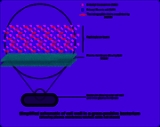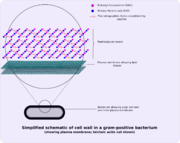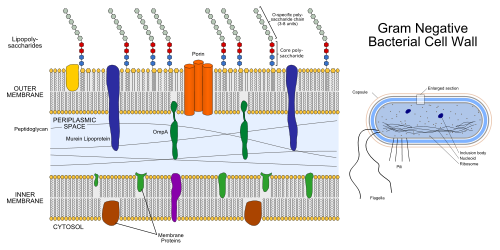
Cell envelope
Encyclopedia
The cell envelope is the cell membrane
and cell wall
plus an outer membrane, if one is present.
Most bacterial cell envelopes fall into two major categories: Gram positive and Gram negative. These are differentiated by their Gram staining
characteristics.
provides structural integrity to the cell. In prokaryotes, the primary function of the cell wall is to protect the cell from internal turgor pressure
caused by the much higher concentrations of proteins and other molecules inside the cell compared to its external environment. The bacterial cell wall differs from that of all other organisms by the presence of peptidoglycan
(poly-N-acetylglucosamine and N-acetylmuramic acid), which is located immediately outside of the cytoplasmic membrane. Peptidoglycan
is responsible for the rigidity of the bacterial cell wall and for the determination of cell shape. It is relatively porous and is not considered to be a permeability barrier for small substrates. While all bacterial cell walls (with a few exceptions e.g. intracellular parasites such as Mycoplasma
) contain peptidoglycan, not all cell walls have the same overall structures. This is notably expressed through the classification into Gram positive and Gram negative bacteria.
 The Gram positive cell wall is characterised by the presence of a very thick peptidoglycan layer, which is responsible for the retention of the crystal violet dyes during the Gram staining
The Gram positive cell wall is characterised by the presence of a very thick peptidoglycan layer, which is responsible for the retention of the crystal violet dyes during the Gram staining
procedure. It is found exclusively in organisms belonging to the Actinobacteria
(or high %G+C Gram positive organisms) and the Firmicutes
(or low %G+C Gram positive organisms). Bacteria within the Deinococcus-Thermus
group may also exhibit Gram positive staining behaviour but contain some cell wall structures typical of Gram negative organisms. Imbedded in the Gram positive cell wall are polyalcohols called teichoic acid
s, some of which are lipid-linked to form lipoteichoic acids
. Because lipoteichoic acid
s are covalently linked to lipids within the cytoplasmic membrane they are responsible for linking the peptidoglycan
to the cytoplasmic membrane. Teichoic acid
s give the Gram positive cell wall an overall negative charge due to the presence of phosphodiester bonds between teichoic acid
monomers.
 Unlike the Gram positive cell wall, the Gram negative cell wall contains a thin peptidoglycan
Unlike the Gram positive cell wall, the Gram negative cell wall contains a thin peptidoglycan
layer adjacent to the cytoplasmic membrane, which is responsible for the cell wall's inability to retain the crystal violet stain upon decolourisation with ethanol during Gram staining
. In addition to the peptidoglycan
layer the Gram negative cell wall also contains an additional outer membrane composed by phospholipid
s and lipopolysaccharide
s which face into the external environment. The highly charged nature of lipopolysaccharide
s confer an overall negative charge to the Gram negative cell wall. The chemical structure of the outer membrane lipopolysaccharide
s is often unique to specific bacterial strains (i.e. sub-species) and is responsible for many of the antigen
ic properties of these strains.
As a phospholipid bilayer, the lipid portion of the outer membrane is largely impermeable to all charged molecules. However, channels called porin
s are present in the outer membrane that allow for passive transport
of many ion
s, sugar
s and amino acid
s across the outer membrane. These molecules are therefore present in the periplasm, the region between the plasma membrane and outer membrane. The periplasm contains the peptidoglycan layer and many proteins responsible for substrate binding or hydrolysis
and reception of extracellular signals. The periplasm is thought to exist as a gel-like state rather than a liquid due to the high concentration of proteins and peptidoglycan
found within it. Because of its location between the cytoplasmic and outer membranes, signals received and substrates bound are available to be transported across the cytoplasmic membrane using transport and signalling proteins imbedded there.
in this class are mycoplasma
and ureaplasma
.
L-form bacteria
are strains bacteria that lack cell walls derived from bacteria that normally possess cell walls.
Cell membrane
The cell membrane or plasma membrane is a biological membrane that separates the interior of all cells from the outside environment. The cell membrane is selectively permeable to ions and organic molecules and controls the movement of substances in and out of cells. It basically protects the cell...
and cell wall
Cell wall
The cell wall is the tough, usually flexible but sometimes fairly rigid layer that surrounds some types of cells. It is located outside the cell membrane and provides these cells with structural support and protection, and also acts as a filtering mechanism. A major function of the cell wall is to...
plus an outer membrane, if one is present.
Most bacterial cell envelopes fall into two major categories: Gram positive and Gram negative. These are differentiated by their Gram staining
Gram staining
Gram staining is a method of differentiating bacterial species into two large groups ....
characteristics.
Function
As in other organisms, the bacterial cell wallCell wall
The cell wall is the tough, usually flexible but sometimes fairly rigid layer that surrounds some types of cells. It is located outside the cell membrane and provides these cells with structural support and protection, and also acts as a filtering mechanism. A major function of the cell wall is to...
provides structural integrity to the cell. In prokaryotes, the primary function of the cell wall is to protect the cell from internal turgor pressure
Turgor pressure
Turgor Pressure or turgidity is the main pressure of the cell contents against the cell wall in plant cells and bacteria cells, determined by the water content of the vacuole, resulting from osmotic pressure, i.e...
caused by the much higher concentrations of proteins and other molecules inside the cell compared to its external environment. The bacterial cell wall differs from that of all other organisms by the presence of peptidoglycan
Peptidoglycan
Peptidoglycan, also known as murein, is a polymer consisting of sugars and amino acids that forms a mesh-like layer outside the plasma membrane of bacteria , forming the cell wall. The sugar component consists of alternating residues of β- linked N-acetylglucosamine and N-acetylmuramic acid...
(poly-N-acetylglucosamine and N-acetylmuramic acid), which is located immediately outside of the cytoplasmic membrane. Peptidoglycan
Peptidoglycan
Peptidoglycan, also known as murein, is a polymer consisting of sugars and amino acids that forms a mesh-like layer outside the plasma membrane of bacteria , forming the cell wall. The sugar component consists of alternating residues of β- linked N-acetylglucosamine and N-acetylmuramic acid...
is responsible for the rigidity of the bacterial cell wall and for the determination of cell shape. It is relatively porous and is not considered to be a permeability barrier for small substrates. While all bacterial cell walls (with a few exceptions e.g. intracellular parasites such as Mycoplasma
Mycoplasma
Mycoplasma refers to a genus of bacteria that lack a cell wall. Without a cell wall, they are unaffected by many common antibiotics such as penicillin or other beta-lactam antibiotics that target cell wall synthesis. They can be parasitic or saprotrophic. Several species are pathogenic in humans,...
) contain peptidoglycan, not all cell walls have the same overall structures. This is notably expressed through the classification into Gram positive and Gram negative bacteria.
Mycobacteria
The Mycobacteria have a cell envelope which is not typical of Gram positives or Gram negatives. The mycobacterial cell envelope does not consist of the outer membrane characteristic of Gram negatives, but has a significant peptidoglycan-arabinogalactan-mycolic acid wall structure which provides an external permeability barrier. Therefore there is thought to be a distinct 'pseudoperiplasm' compartment between the cytoplasmic membrane and this outer barrier. The nature of this compartment is not well understood.The Gram positive cell wall

Gram staining
Gram staining is a method of differentiating bacterial species into two large groups ....
procedure. It is found exclusively in organisms belonging to the Actinobacteria
Actinobacteria
Actinobacteria are a group of Gram-positive bacteria with high guanine and cytosine content. They can be terrestrial or aquatic. Actinobacteria is one of the dominant phyla of the bacteria....
(or high %G+C Gram positive organisms) and the Firmicutes
Firmicutes
The Firmicutes are a phylum of bacteria, most of which have Gram-positive cell wall structure. A few, however, such as Megasphaera, Pectinatus, Selenomonas and Zymophilus, have a porous pseudo-outer-membrane that causes them to stain Gram-negative...
(or low %G+C Gram positive organisms). Bacteria within the Deinococcus-Thermus
Deinococcus-Thermus
The Deinococcus-Thermus are a small group of bacteria composed of cocci highly resistant to environmental hazards.There are two main groups.* The Deinococcales include two families, with three genera, Deinococcus and Truepera, the former with several species that are resistant to radiation; they...
group may also exhibit Gram positive staining behaviour but contain some cell wall structures typical of Gram negative organisms. Imbedded in the Gram positive cell wall are polyalcohols called teichoic acid
Teichoic acid
Teichoic acids are bacterial polysaccharides of glycerol phosphate or ribitol phosphate linked via phosphodiester bonds.-Location and structure:...
s, some of which are lipid-linked to form lipoteichoic acids
Teichoic acid
Teichoic acids are bacterial polysaccharides of glycerol phosphate or ribitol phosphate linked via phosphodiester bonds.-Location and structure:...
. Because lipoteichoic acid
Lipoteichoic acid
Lipoteichoic acid is a major constituent of the cell wall of Gram-positive bacteria. These organisms have an inner membrane and, external to it, a thick peptidoglycan layer. It consists of teichoic acids, long chains of ribitol phosphate and is anchored to the lipid bilayer via a glyceride...
s are covalently linked to lipids within the cytoplasmic membrane they are responsible for linking the peptidoglycan
Peptidoglycan
Peptidoglycan, also known as murein, is a polymer consisting of sugars and amino acids that forms a mesh-like layer outside the plasma membrane of bacteria , forming the cell wall. The sugar component consists of alternating residues of β- linked N-acetylglucosamine and N-acetylmuramic acid...
to the cytoplasmic membrane. Teichoic acid
Teichoic acid
Teichoic acids are bacterial polysaccharides of glycerol phosphate or ribitol phosphate linked via phosphodiester bonds.-Location and structure:...
s give the Gram positive cell wall an overall negative charge due to the presence of phosphodiester bonds between teichoic acid
Teichoic acid
Teichoic acids are bacterial polysaccharides of glycerol phosphate or ribitol phosphate linked via phosphodiester bonds.-Location and structure:...
monomers.
The Gram negative cell wall

Peptidoglycan
Peptidoglycan, also known as murein, is a polymer consisting of sugars and amino acids that forms a mesh-like layer outside the plasma membrane of bacteria , forming the cell wall. The sugar component consists of alternating residues of β- linked N-acetylglucosamine and N-acetylmuramic acid...
layer adjacent to the cytoplasmic membrane, which is responsible for the cell wall's inability to retain the crystal violet stain upon decolourisation with ethanol during Gram staining
Gram staining
Gram staining is a method of differentiating bacterial species into two large groups ....
. In addition to the peptidoglycan
Peptidoglycan
Peptidoglycan, also known as murein, is a polymer consisting of sugars and amino acids that forms a mesh-like layer outside the plasma membrane of bacteria , forming the cell wall. The sugar component consists of alternating residues of β- linked N-acetylglucosamine and N-acetylmuramic acid...
layer the Gram negative cell wall also contains an additional outer membrane composed by phospholipid
Phospholipid
Phospholipids are a class of lipids that are a major component of all cell membranes as they can form lipid bilayers. Most phospholipids contain a diglyceride, a phosphate group, and a simple organic molecule such as choline; one exception to this rule is sphingomyelin, which is derived from...
s and lipopolysaccharide
Lipopolysaccharide
Lipopolysaccharides , also known as lipoglycans, are large molecules consisting of a lipid and a polysaccharide joined by a covalent bond; they are found in the outer membrane of Gram-negative bacteria, act as endotoxins and elicit strong immune responses in animals.-Functions:LPS is the major...
s which face into the external environment. The highly charged nature of lipopolysaccharide
Lipopolysaccharide
Lipopolysaccharides , also known as lipoglycans, are large molecules consisting of a lipid and a polysaccharide joined by a covalent bond; they are found in the outer membrane of Gram-negative bacteria, act as endotoxins and elicit strong immune responses in animals.-Functions:LPS is the major...
s confer an overall negative charge to the Gram negative cell wall. The chemical structure of the outer membrane lipopolysaccharide
Lipopolysaccharide
Lipopolysaccharides , also known as lipoglycans, are large molecules consisting of a lipid and a polysaccharide joined by a covalent bond; they are found in the outer membrane of Gram-negative bacteria, act as endotoxins and elicit strong immune responses in animals.-Functions:LPS is the major...
s is often unique to specific bacterial strains (i.e. sub-species) and is responsible for many of the antigen
Antigen
An antigen is a foreign molecule that, when introduced into the body, triggers the production of an antibody by the immune system. The immune system will then kill or neutralize the antigen that is recognized as a foreign and potentially harmful invader. These invaders can be molecules such as...
ic properties of these strains.
As a phospholipid bilayer, the lipid portion of the outer membrane is largely impermeable to all charged molecules. However, channels called porin
Porin (protein)
Porins are beta barrel proteins that cross a cellular membrane and act as a pore through which molecules can diffuse. Unlike other membrane transport proteins, porins are large enough to allow passive diffusion, i.e., they act as channels that are specific to different types of molecules...
s are present in the outer membrane that allow for passive transport
Passive transport
Passive transport means moving biochemicals and other atomic or molecular substances across membranes. Unlike active transport, this process does not involve chemical energy, because, unlike in an active transport, the transport across membrane is always coupled with the growth of entropy of the...
of many ion
Ion
An ion is an atom or molecule in which the total number of electrons is not equal to the total number of protons, giving it a net positive or negative electrical charge. The name was given by physicist Michael Faraday for the substances that allow a current to pass between electrodes in a...
s, sugar
Sugar
Sugar is a class of edible crystalline carbohydrates, mainly sucrose, lactose, and fructose, characterized by a sweet flavor.Sucrose in its refined form primarily comes from sugar cane and sugar beet...
s and amino acid
Amino acid
Amino acids are molecules containing an amine group, a carboxylic acid group and a side-chain that varies between different amino acids. The key elements of an amino acid are carbon, hydrogen, oxygen, and nitrogen...
s across the outer membrane. These molecules are therefore present in the periplasm, the region between the plasma membrane and outer membrane. The periplasm contains the peptidoglycan layer and many proteins responsible for substrate binding or hydrolysis
Hydrolysis
Hydrolysis is a chemical reaction during which molecules of water are split into hydrogen cations and hydroxide anions in the process of a chemical mechanism. It is the type of reaction that is used to break down certain polymers, especially those made by condensation polymerization...
and reception of extracellular signals. The periplasm is thought to exist as a gel-like state rather than a liquid due to the high concentration of proteins and peptidoglycan
Peptidoglycan
Peptidoglycan, also known as murein, is a polymer consisting of sugars and amino acids that forms a mesh-like layer outside the plasma membrane of bacteria , forming the cell wall. The sugar component consists of alternating residues of β- linked N-acetylglucosamine and N-acetylmuramic acid...
found within it. Because of its location between the cytoplasmic and outer membranes, signals received and substrates bound are available to be transported across the cytoplasmic membrane using transport and signalling proteins imbedded there.
Bacteria lacking cell wall
The cell envelopes of the bacterial class of mollicutes do not have a cell wall. The main pathogenic bacteriaPathogenic bacteria
Pathogenic bacteria are bacteria that cause bacterial infection. This article deals with human pathogenic bacteria.Although the vast majority of bacteria are harmless or beneficial, quite a few bacteria are pathogenic...
in this class are mycoplasma
Mycoplasma
Mycoplasma refers to a genus of bacteria that lack a cell wall. Without a cell wall, they are unaffected by many common antibiotics such as penicillin or other beta-lactam antibiotics that target cell wall synthesis. They can be parasitic or saprotrophic. Several species are pathogenic in humans,...
and ureaplasma
Ureaplasma
Ureaplasma is a genus of bacteria belonging to the family Mycoplasmataceae. As the name imples, ureaplasma is urease positive.It includes the species:* Ureaplasma canigenitalium* Ureaplasma cati* Ureaplasma diversum...
.
L-form bacteria
L-form bacteria
L-form bacteria, also known as L-phase bacteria, L-phase variants, and cell wall-deficient bacteria, are strains of bacteria that lack cell walls...
are strains bacteria that lack cell walls derived from bacteria that normally possess cell walls.

